Tartan
Tartan (Scottish Gaelic: breacan [ˈpɾʲɛxkən]) is a patterned cloth consisting of criss-crossed, horizontal and vertical bands in multiple colours. Tartans originated in woven wool, but now they are made in many other materials. Tartan is particularly associated with Scotland; Scottish kilts almost always have tartan patterns.
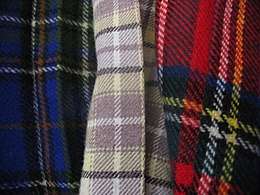
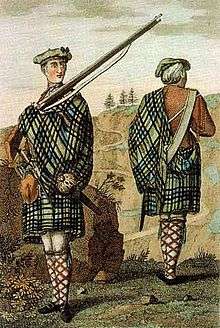
| Part of a series on the |
| Culture of Scotland |
|---|
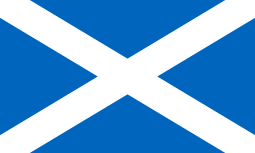 |
| History |
| People |
|
Traditions
|
|
Mythology and folklore
|
| Cuisine |
|
| Religion |
| Art |
| Literature |
|
Music and performing arts
|
|
|
Monuments |
|
Tartan is made with alternating bands of coloured (pre-dyed) threads woven as both warp and weft at right angles to each other. The weft is woven in a simple twill, two over—two under the warp, advancing one thread at each pass. This forms visible diagonal lines where different colours cross, which give the appearance of new colours blended from the original ones. The resulting blocks of colour repeat vertically and horizontally in a distinctive pattern of squares and lines known as a sett.
Tartan is often mistakenly called "plaid" (particularly in North America), but in Scotland, a plaid is a large piece of tartan cloth, worn as a type of kilt or large shawl. The term plaid is also used in Scotland for an ordinary blanket such as one would have on a bed.[2]
The Dress Act of 1746 attempted to bring the warrior clans under government control by banning the tartan and other aspects of Gaelic culture. When the law was repealed in 1782, it was no longer ordinary Highland dress, but was adopted instead as the symbolic national dress of Scotland, a status that was widely popularised after King George IV wore a tartan kilt in his 1822 visit to Scotland.
Until the middle of the nineteenth century, the highland tartans were only associated with either regions or districts, rather than any specific Scottish clan. This was because like other materials, tartan designs were produced by local weavers for local tastes and would usually only use the natural dyes available in that area, as synthetic dye production was non-existent and transportation of other dye materials across long distances was prohibitively expensive.
The patterns were simply different regional checked-cloth patterns, chosen by the wearer's preference—in the same way as people nowadays choose what colours and patterns they like in their clothing, without particular reference to propriety. It was not until the mid-nineteenth century that many patterns were created and artificially associated with Scottish clans, families, or institutions who were (or wished to be seen as) associated in some way with a Scottish heritage.[3] The Victorians' penchant for ordered taxonomy and the new chemical dyes then available meant that the idea of specific patterns of bright colours, or "dress" tartans, could be created and applied to a faux-nostalgic view of Scottish history.
Today tartan is no longer limited to textiles, but is used on mediums such as paper, plastics, packaging, and wall coverings.[4]
Etymology and terminology
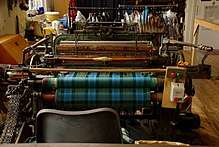
The English and Scots word "tartan" is most likely derived from the French tartarin meaning "Tartar cloth".[5] It has also been suggested that "tartan" may be derived from modern Scottish Gaelic tarsainn,[6] meaning "across". Today "tartan" usually refers to coloured patterns, though originally a tartan did not have to be made up of any pattern at all. As late as the 1830s tartan was sometimes described as "plain coloured ... without pattern".[7] Patterned cloth from the Gaelic-speaking Scottish Highlands was called breacan, meaning many colours. Over time the meanings of tartan and breacan were combined to describe certain type of pattern on a certain type of cloth. The pattern of a tartan is called a sett. The sett is made up of a series of woven threads which cross at right angles.[7]
Today tartan is generally used to describe the pattern, not limited to textiles.[7] In North America the term plaid is commonly used to describe tartan.[2] The word plaid, derived from the Scottish Gaelic plaide, meaning "blanket",[8] was first used of any rectangular garment, sometimes made up of tartan, particularly that which preceded the modern kilt (see: belted plaid). In time, plaid was used to describe blankets themselves.[2]
Construction
Each thread in the warp crosses each thread in the weft at right angles. Where a thread in the warp crosses a thread of the same colour in the weft they produce a solid colour on the tartan, while a thread crossing another of a different colour produces an equal mixture of the two colours. Thus, a set of two base colours produces three different colours including one mixture. The total number of colours, including mixtures, increases quadratically with the number of base colours so a set of six base colours produces fifteen mixtures and a total of twenty-one different colours. This means that the more stripes and colours used, the more blurred and subdued the tartan's pattern becomes.[7][9]
The sequence of threads, known as the sett, starts at an edge and either repeats or reverses on what are called pivot points. In diagram A, the sett reverses at the first pivot, then repeats, then reverses at the next pivot, and will carry on in this manner horizontally. In diagram B, the sett reverses and repeats in the same way as the warp, and also carries on in the same manner vertically. The diagrams left illustrate the construction of a "symmetrical" tartan. However, on an "asymmetrical" tartan, the sett does not reverse at the pivots, it just repeats at the pivots. Also, some tartans (very few) do not have exactly the same sett for the warp and weft. This means the warp and weft will have alternate thread counts.
Tartan is recorded by counting the threads of each colour that appear in the sett.[lower-alpha 1] The thread count not only describes the width of the stripes on a sett, but also the colours used. For example, the thread count "K4 R24 K24 Y4" corresponds to 4 black threads, 24 red threads, 24 black threads, 4 yellow threads.[10] Usually the thread count is an even number to assist in manufacture. The first and last threads of the thread count are the pivot points.[4] Though thread counts are indeed quite specific, they can be modified in certain circumstances, depending on the desired size of the tartan. For example, the sett of a tartan (about 6 inches) may be too large to fit upon the face of a necktie. In this case the thread count has to be reduced in proportion (about 3 inches).[10]
_A.svg.png) Diagram A, the warp
Diagram A, the warp_B.svg.png) Diagram B, the weft
Diagram B, the weft_C.svg.png) Diagram C, the tartan. The combining of the warp and weft.
Diagram C, the tartan. The combining of the warp and weft.
Colour: shades and meaning
.png)
The shades of colour in tartan can be altered to produce variations of the same tartan. The resulting variations are termed: modern, ancient, and muted.[lower-alpha 2] These terms only refer to dye colours.[11]
- Modern colours
- Describes a tartan that is coloured using chemical dye, as opposed to natural dye. In the mid-19th century natural dyes began to be replaced by chemical dyes which were easier to use and were more economic for the booming tartan industry. Chemical dyes tend to produce a very strong, vivid colour compared to natural dyes. In modern colours, setts made up of blue, black, and green tend to be obscured.
- Ancient colours
- Refers to a lighter shade of tartan. These shades are meant to represent the colours that would result from fabric aging over time.
- Muted colours
- Also called reproduction colours, refers to tartan which is shade between modern and ancient. Although this type of coloring is very recent, dating only from the early 1970s, these shades are thought to be the closest match to the colours attained by natural dyes used before the mid-19th century.
The idea that the various colours used in tartan have a specific meaning is purely a modern one. One such myth is that red tartans were "battle tartans", designed so they would not show blood. It is only recently created tartans, such as Canadian provincial and territorial tartans (beginning 1950s) and U.S. state tartans (beginning 1980s), that are designed with certain symbolic meaning for the colours used. For example, the colour green sometimes represents prairies or forests, blue can represent lakes and rivers, and the colour yellow is sometimes used to represent various crops.[12]
History
Pre-medieval origins
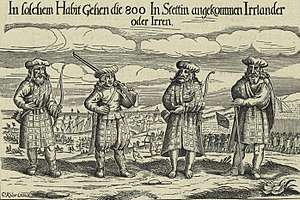
Today tartan is mostly associated with Scotland; however, the earliest evidence of tartan is found far afield from Britain. According to the textile historian E. J. W. Barber, the Hallstatt culture of Central Europe, which is linked with ancient Celtic populations and flourished between the 8th and 6th centuries BC, produced tartan-like textiles. Some of them were discovered in 2004, remarkably preserved, in the Hallstatt salt mines near Salzburg, Austria.[6] Textile analysis of fabric from the Tarim mummies in Xinjiang, northwestern China has also shown it to be similar to that of the Iron Age Hallstatt culture.[14] Tartan-like leggings were found on the "Cherchen Man", a 3,000 year-old mummy found in the Taklamakan Desert.[15] Similar finds have been made in central Europe and Scandinavia.[7]
The earliest documented tartan in Britain, known as the "Falkirk" tartan, dates from the 3rd century AD. It was uncovered at Falkirk in Stirlingshire, Scotland, near the Antonine Wall. The fragment, held in the National Museums of Scotland, was stuffed into the mouth of an earthenware pot containing almost 2,000 Roman coins.[16] The Falkirk tartan has a simple check design, of natural light and dark wool. Early forms of tartan like this are thought to have been invented in pre-Roman times, and would have been popular among the inhabitants of the northern Roman provinces[17][18] as well as in other parts of Northern Europe such as Jutland, where the same pattern was prevalent.[19][20][21]
Early modern tartans
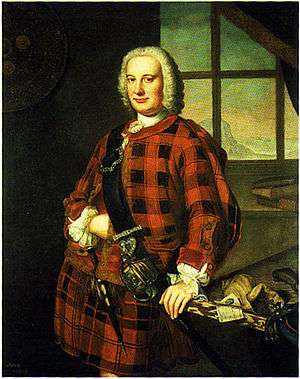
The tartan as we know it today is not thought to have existed in Scotland before the 16th century. By the late 16th century there are numerous references to striped or checkered plaids. It is not until the late 17th or early 18th century that any kind of uniformity in tartan is thought to have occurred.[23] Martin Martin, in A Description of the Western Islands of Scotland, published in 1703, wrote that Scottish tartans could be used to distinguish the inhabitants of different regions. He expressly wrote that the inhabitants of various islands and the mainland of the Highlands were not all dressed alike, but that the setts and colours of the various tartans varied from isle to isle.[lower-alpha 4] As he does not mention the use of a special pattern by each family, it would appear that such a distinction is a modern one.
For many centuries the patterns were loosely associated with the weavers of a particular area, though it was common for highlanders to wear a number of different tartans at the same time. A 1587 charter granted to Hector Maclean of Duart requires feu duty on land paid as 60 ells of cloth of white, black and green colours. A witness of the 1689 Battle of Killiecrankie describes "McDonnell's men in their triple stripes". From 1725 the government force of the Highland Independent Companies introduced a standardised tartan chosen to avoid association with any particular clan, and this was formalised when they became the Black Watch regiment in 1739.
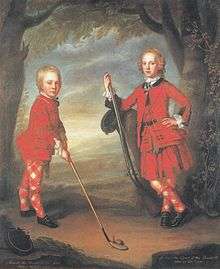
The most effective fighters for Jacobitism were the supporting Scottish clans, leading to an association of tartans with the Jacobite cause. Efforts to pacify the Highlands led to the Dress Act of 1746, banning tartans, except for the Highland regiments of the British army. "[I]t was probably their use of it which gave birth to the idea of differentiating tartan by clans; for as the Highland regiments were multiplied ... so their tartan uniforms were differentiated."[25]
The Act was repealed in 1782, due to the efforts of the Highland Society of London. William Wilson & Sons of Bannockburn became the foremost weaving manufacturer around 1770 as suppliers of tartan to the military. Wilson corresponded with his agents in the Highlands to get information and samples of cloth from the clan districts to enable him to reproduce "perfectly genuine patterns" and recorded over 200 setts by 1822, many of which were tentatively named. The Cockburn Collection of named samples made by William Wilson & Sons was put together between 1810 and 1820 and is now in the Mitchell Library in Glasgow.[26] At this time many setts were simply numbered, or given fanciful names such as the "Robin Hood" tartan, not associated with any specific clan.
The absence of early clan tartans
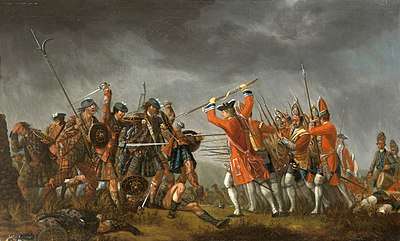
It is generally regarded that "clan tartans" date no earlier than the beginning of the 19th century, and are an example of an invented tradition. Contemporary portraits show that although tartan is of an early date, the pattern worn depended not on the wearer's clan, but rather upon his or her present affiliation, place of origin or current residence, or personal taste.
David Morier's well-known painting of the Highland charge at the Battle of Culloden (right) shows the clansmen wearing various tartans. The setts painted all differ from one another and very few of those painted resemble any of today's clan tartans.[28] It is maintained by many that clan tartans were not in use at the time of the Battle of Culloden in 1746. The method of identifying friend from foe was not through tartans but by the colour of ribbon worn upon the bonnet.[lower-alpha 5][lower-alpha 6]
The idea of groups of men wearing the same tartan is thought to originate from the military units in the 18th century. Evidence suggests that in 1725 the Independent Highland Companies may have worn a uniform tartan.[28]
Modern tartans
By the 19th century the Highland romantic revival, inspired by James Macpherson's Ossian poems and the writings of Sir Walter Scott, led to wider interest, with clubs like the Celtic Society of Edinburgh welcoming Lowlanders. The pageantry invented for the 1822 visit of King George IV to Scotland brought a sudden demand for tartan cloth and made it the national dress of the whole of Scotland, rather than just the Highlands and Islands, with the invention of many new clan-specific tartans to suit.
Georgian royal patronage
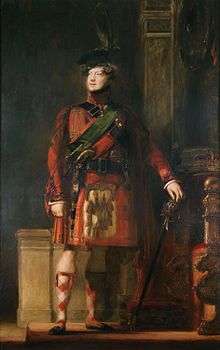
The popularity of tartan was greatly increased by the royal visit of George IV to Edinburgh in 1822. George IV was the first reigning monarch to visit Scotland in 171 years.[32] The festivities surrounding the event were originated by Sir Walter Scott who founded the Celtic Society of Edinburgh in 1820. Scott and the Celtic Society urged Scots to attend festivities "all plaided and plumed in their tartan array".[33] One contemporary writer sarcastically described the pomp that surrounded the celebrations as "Sir Walter's Celtified Pagentry".[33][34]
The Georgian tartan craze
Following the royal visit several books which documented tartans added to the craze. James Logan's romanticised work The Scottish Gael, published in 1831, was one such publication which led the Scottish tartan industry to invent clan tartans.[35] The first publication showing plates of clan tartans was the Vestiarium Scoticum, published in 1842.[36]
The Vestiarium was the work of two brothers: John Sobieski and Charles Allen Hay. The brothers, who called themselves John Sobieski Stolberg Stuart and Charles Edward Stuart, first appeared in Scotland in 1822. The two claimed to be grandsons of Prince Charles Edward Stuart and his wife Princess Louise of Stolberg, and consequently later became known as the "Sobieski Stuarts". The Sobieski Stuarts claimed that the Vestiarium was based upon a copy of an ancient manuscript on clan tartans—a manuscript which they never managed to produce.[37] The Vestiarium was followed by the equally dubious The Costume of the Clans two years later.[35] The romantic enthusiasm that Logan and the Sobieski Stuarts generated with their publications led the way for other tartan books in the 19th century.[33][36]
Victorian royal patronage

Twenty years after her uncle's visit to Scotland, Queen Victoria and her husband Prince Albert made their first trip to the Scottish Highlands. The Queen and prince bought Balmoral Castle in 1848 and hired a local architect to re-model the estate in "Scots Baronial" style. Prince Albert personally took care of the interior design, where he made great use of tartan. He used the red Royal Stewart and the green Hunting Stewart tartans for carpets, while using the Dress Stewart for curtains and upholstery. The Queen designed the Victoria tartan, and Prince Albert the Balmoral, still used as a royal tartan today.[39]
Victoria and Albert spent a considerable amount of time at their estate, and in doing so hosted many "Highland" activities. Victoria was attended by pipers and her children were attired in Highland dress. Prince Albert himself loved watching the Highland games.[40][lower-alpha 8] Ironically, as the craze swept over Scotland the Highland population suffered grievously from the Highland Clearances, when thousands of Gaelic-speaking Scots from the Highlands and Isles were evicted by landlords (in many cases the very men who would have been their own clan chiefs) to make way for sheep.[33]
Modern registration of clan tartans
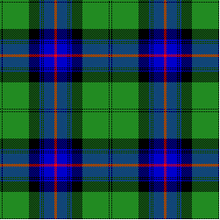
The naming and registration of official clan tartans began on 8 April 1815, when the Highland Society of London (founded 1778) resolved that all the clan chiefs each "be respectfully solicited to furnish the Society with as much of the Tartan of his Lordship's Clan as will serve to Show the Pattern and to Authenticate the Same by Attaching Thereunto a Card bearing the Impression of his Lordship's Arms." Many had no idea of what their tartan might be, but were keen to comply and to provide authentic signed and sealed samples. Alexander Macdonald, 2nd Baron Macdonald was so far removed from his Highland heritage that he wrote to the Society: "Being really ignorant of what is exactly The Macdonald Tartan, I request you will have the goodness to exert every Means in your power to Obtain a perfectly genuine Pattern, Such as Will Warrant me in Authenticating it with my Arms."
Today tartan and "clan tartan" is an important part of a Scottish clan. Almost all Scottish clans have several tartans attributed to their name. Several clans have "official" tartans. Although it is possible for anyone to create a tartan and name it any name they wish, the only person with the authority to make a clan's tartan "official" is the chief.[lower-alpha 9]
In some cases, following such recognition from the clan chief, the clan tartan is recorded and registered by the Lord Lyon King of Arms. Once approved by the Lord Lyon, after recommendation by the Advisory Committee on Tartan, the clan tartan is then recorded in the Lyon Court Books.[28] In at least one instance a clan tartan appears in the heraldry of a clan chief and is considered by the Lord Lyon as the "proper" tartan of the clan.[lower-alpha 10]
Modern-day tartans also encompass registered tartans for Irish clans, (for example, the surname Fitzpatrick has two registered tartans[43]) Counties, and other Gaelic and Celtic nations, such as the Isle of Man, Wales, and Cornwall.
Popular tartans
It is generally stated that one of the most popular tartans today is the Royal Stewart tartan. This is the personal tartan of Queen Elizabeth II. The sett was first published in 1831 in the book The Scottish Gael by James Logan. In addition to its use in clothing, such as skirts and scarves, Royal Stewart tartan has also appeared on biscuit tins for Scottish shortbread.[44]
Another popular tartan is the Black Watch (also known as Grant Hunting, Universal, and Government).[12] This tartan, a darkened variant of the main Clan Campbell tartan (Ancient or Old Campbell), was used and is still used by several military units in the British Army and other Commonwealth forces.
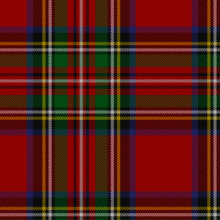 Royal Stewart tartan
Royal Stewart tartan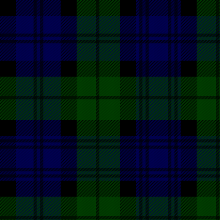 Black Watch tartan
Black Watch tartan
Other tartans
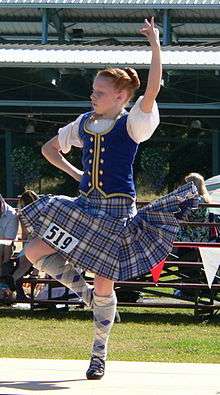
In addition to clan tartans, many tartan patterns have been developed for individuals, families, districts, institutions, and corporations. They have also been created for various events and certain ethnic groups.[lower-alpha 11] Tartan has had a long history with the military and today many military units—particularly those within the Commonwealth—have tartan dress uniforms.[46] Tartans or tartan-like plaid patterns are also commonly worn as skirts or jumpers / pinafores in Catholic school uniform and other private school uniform codes in North America and also in many public and private schools in New Zealand.
Regional tartans
In addition to the original Scottish regional tartans and modern district tartans, modern tartans have been created for regions outside of Scotland.
Many regional tartans are officially recognised by government bodies. Most Canadian provinces and territories have an official tartan, with the first dating from 1956.[47] Canada has an official national tartan that was originally designed to commemorate the introduction of its new maple leaf flag, and was made an official national emblem in 2011.[48] Several Canadian counties and municipalities also have official tartans.[lower-alpha 12]
Many of the U.S. states also have official tartans, with the first dating from 1988. In Scotland at least two local government councils have official tartans.[51]
Dress, hunting, and mourning tartans
Tartans are sometimes differentiated from another with the same name by the label dress, hunting, or rarely mourning.
Dress tartans are based on the earasaid tartans worn by Highland women in the 17th and 18th centuries.[lower-alpha 13] Dress tartans tend to be made by replacing a prominent colour with the colour white. They are commonly used today in Highland dancing.
Hunting tartans also seem to be a Victorian conception, although there is some evidence of early tartans with camouflage colours.[53][lower-alpha 14] These tartans tend to be made up of subdued colours, such as dark blues and greens. Despite the name, hunting tartans have very little to do with actual hunting.[2]
Mourning tartans, though quite rare, are associated with death and funerals. They are usually designed using combinations of black and white, or by replacing bright colors such as reds and yellows in a traditional tartan with black, white, or grey.[55]
Corporate tartans and commercial "tartan-ware"
.jpg)
Clever Victorian entrepreneurs not only created new tartans, but new tartan objects called tartan-ware. Tartan was incorporated in an assortment of common household objects, such as snuffboxes, jewellery cases, tableware, sewing accessories, and desk items. Tourists visiting the Scottish Highlands went home with it, and Scottish-based businesses sent tartanware out as gifts to customers. Some of the more popular tartans were the Stewart, MacDonald, McGregor, McDuff, MacBeth, and Prince Charlie.[56] Today tartanware is widely collected in England and Scotland.[57]
Fashion tartans
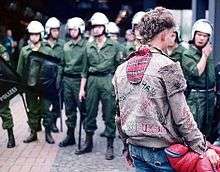
In the Victorian and Edwardian eras, tartan-clad garments were featured in fashion catalogues. By then, tartan had shifted from being mainly a component of men's clothing to become an important part of women's fashion. In consequence of its association with the British aristocracy and military, tartan developed an air of dignity and exclusivity. Because of this, tartan has made reappearances in the world of fashion several times.
For instance, tartan made a resurgence in its use in punk fashion. In the late 1970s, punk music was a way for youth in the British Isles to voice their discontent with the ruling class. The unorthodox use of tartan, which had long been associated with authority and gentility, was then seen as the expression of discontent against modern society. In this way tartan, worn unconventionally, became an anti-establishment symbol.[58][59]
Popular in the mid 1970s, the Scottish teeny bopper band the Bay City Rollers were described by the British Hit Singles & Albums reference book as “tartan teen sensations from Edinburgh".[60]
Tartan registration
.png)
Depending upon how "different tartan" is defined, it has been estimated that there are about 3,500[61] to 7,000[62] different tartans, with around 150 new designs being created every year.[62] With four ways of presenting the hues in the tartan—"modern", "ancient", "weathered", and "muted"[lower-alpha 2] colours—there are thus about 14,000 recognised tartan variations from which to choose. The 7,000 figure above includes many of these variations counted as though they were different tartans.[62]
Until the late 20th century, instead of a central, official tartan registry, several independent organisations located in Scotland, Canada, and the United States documented and recorded tartans.[63] In the 1960s, a Scottish society called the Scottish Tartans Society (now defunct) was created to record and preserve all known tartan designs.[64] The society's register, the Register of All Publicly Known Tartans (RAPKT), contains about 2,700 different designs of tartan.[61] The society, however, ran into financial troubles in about the year 2000, and folded.[65] Former members of the society then formed two new Scottish-based organisations – the Scottish Tartans Authority (STA) and the Scottish Tartans World Register (STWR). Both of these societies initially based their databases on the RAPKT. The STA's database, the International Tartan Index (ITI) consists of about 3,500 different tartans (with over 7,000, counting variants), as of 2004.[61] The STWR's self-titled Scottish Tartans World Register database is made up of about 3,000 different designs as of 2004.[61] Both organisations are registered Scottish charities and record new tartans (free in the case of STS and for a fee in the case of STWR) on request.[66][67] The STA's ITI is larger, in part, because it has absorbed the entries recorded in the TartanArt database formerly maintained by the merged International Association of Tartan Studies and Tartan Educational and Cultural Association (IATS/TECA), based in the United States, and with whom the STA is directly affiliated.
The Scottish Register of Tartans (SRT) is Scotland's official tartan register. The SRT is maintained and administrated by the National Archives of Scotland (NAS), a statutory body based in Edinburgh.[68] The aim of the Register is to provide a definitive and accessible resource to promote and preserve tartans. It also aims to be the definitive source for the registration of new tartans (that pass NAS criteria for inclusion). The register itself is made up of the existing registers of the STA and the STWR as they were at the time of the SRT's launch, and new registrations from 5 February 2009 onward. On the Register's website users can register new tartans (for a fee), search for and request the threadcounts of existing tartans and receive notifications of newly registered tartans.[69][70] One criticism of the SRT and NAS's management of it is that its exclusivity, in both cost and criteria, necessarily means that it cannot actually achieve its goals of definiteness, preservation and open access. The current version of the STA's ITI, for example, already contains a large number of tartans that do not appear in the SRT, and the gulf will only widen under current policy.[71]
Tartan etiquette
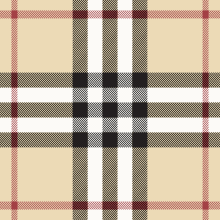
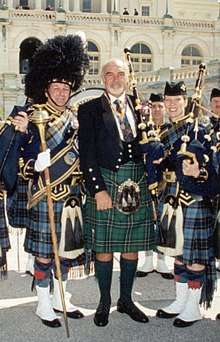
Since the Victorian era, authorities on tartan have claimed that there is an etiquette to wearing tartan, specifically tartan attributed to clans or families. Even so, there are no laws or rules on who can, or cannot, wear a particular tartan. The concept of the entitlement to certain tartans has led to the term of universal tartan, or free tartan, which describes tartan which can be worn by anyone. Traditional examples of such are Black Watch, Caledonian, Hunting Stewart, and Jacobite tartans, and many district or regional tartans.[72] In the same line of opinion, some tartan attributed to the British Royal Family are claimed by some to be "off limits" to non-royalty.[73][74]
However, some modern tartans are protected by trademark law, and the trademark proprietor can, in certain circumstances, prevent others from selling that tartan.[12] The "Burberry Check" of the English fashion house, first designed in early 1920s, is an instantly recognisable tartan that is very well known around the world[75] and is an example of a tartan that is protected.[lower-alpha 15]
Many books on Scottish clans list such rules and guidelines.[12] One such opinion is that people not bearing a clan surname, or surname claimed as a sept of a clan, should not wear the tartan of their mother's clan.[78] This opinion is enforced by the fact that in the Scottish clan system, the Lord Lyon states that membership to a clan technically passes through the surname. This means that children who bear their father's surname belong to the father's clan (if any), and that children who bear their mother's surname (her maiden name) belong to their mother's clan (if any).[79] Also, the Lord Lyon states that a clan tartan should only be worn by those who profess allegiance to that clan's chief.[80]
Some clan societies even claim that certain tartans are the personal property of a chief or chieftain, and in some cases they allow their clansfolk "permission" to wear a tartan.[lower-alpha 16] According to the Scottish Tartans Authority — which is an establishment of the Scottish tartan industry — the Balmoral tartan should not be worn by anyone who is not part of the British Royal Family. Even so, some weavers outside of the United Kingdom ignore the "longstanding convention" of the British Royal Family's "right" to this tartan. The society also claims that non-royals who wear this tartan are treated with "great disdain" by the Scottish tartan industry.[lower-alpha 17]
Generally, a more liberal attitude is taken by those in the business of selling tartan, stressing that anyone may wear any tartan they like. The claimed "rules" are mere conventions (some of which are recent creations), with different levels of importance depending on the symbolic meaning of the tartan on some particular occasion. For example, when a district tartan is worn at a football game, or a family tartan at a family event, such as the investiture of a new clan chief, the issue of wearing the event's tartan is of greater concern than wearing the same tartan when attending Highland Games where no event is scheduled where the tartan would have special significance. The same rules apply as do to wearing any clothing that prominently displays colors with national or political significance, such as un-patterned orange or green cloth in Ireland (regardless of whether it is worn as a kilt), or red, white, and blue colors at national events in France or the United States.
See also
- Argyle (pattern)
- Carnegie Mellon University, whose athletic mascot is Scotty the Scottie Dog; their athletic teams are known as "The Tartans"
- Check (pattern)
- Flannel
- List of tartans
- List of U.S. state tartans, officially recognised tartans of states in the US (created in the 1980s)
- Madras (cloth)
- Regional tartans of Canada, officially recognised tartans of the provinces and territories of Canada (created in the 1950s)
- Sobieski Stuarts
- Tartan Army, popular name for the fans of the Scotland football team
- Tartan Day, a day of celebration, in Canada and the US, recognising the influence of Scottish immigration to these countries
- Tartanry
- Vestiarium Scoticum, the Victorian forgery that is the source of many of today's clan tartans
Notes
- Early collectors of tartan recorded setts by measuring the width of each stripe in one eighths of an inch.[10]
- "Muted" colours are also called "reproduction" colours.
- The Highlanders depicted were sometimes mistakenly described as Irish "Irrländer oder Irren". It is thought that the soldiers depicted were part of Mackay's Regiment which served under Gustavus Adolphus in Stettin (present-day Szczecin, Poland). The men are depicted in dress varying from belted plaid, draped plaids and tartan breeches with tartan hose.[13]
- Martin Martin wrote: "each Isle differs from the other in thir fancy of making Plaids, as to the Stripes in Breadth and Colours. this Humour is as different thro the main Land of the Highlands, in so-far that they who have seen these Places are able, at the first view of a Man's Plaid to guess the Place of his Residence ..."[24]
- James Ray who served in the government forces at the Battle of Culloden, wrote in 1752: "In their flight I came up with a pretty young Highlander, who called out to me, Hold your Hand, I'm a Cambell. On which I asked him, Where's your Bonnet ? He reply'd, Somebody have snatched it off my Head. I only mention this to shew how we distinguished our loyal Clans from the Rebels ; they being dress'd and equip'd all in one Way, except the Bonnet ; ours having a red or yellow Cross of Cloath or Ribbon ; theirs a white Cockade".[29]
- Kass McGann, citing A Journal of the Expedition of Prince Charles Edward in 1745, by a Highland Officer which states: "We M’Donalds were much preplex’d, in the event of ane ingagement, how to distinguish ourselves from our bretheren and nighbours the M’Donalds of Sky, seeing we were both Highlanders and both wore heather in our bonnets, only our white cockades made some distinction", claims that this further supports the thought that the idea of clan tartans is a late invention.[30]
- Sir David Wilkie's portrait of George IV depicts the king as being much slimmer than he actually was. Wilkie covered up the fact the king's kilt was too short—sitting well above the knees—and also left out the pink tights the king wore to hide his bare legs.[31]
- Queen Victoria wrote of her time in Scotland: "Yes; and I feel a sort of reverence in going over these scenes in this most beautiful country, which I am proud to call my own, where there was such devoted loyalty to the family of my ancestors—for Stuart blood is in my veins, and I am now their representative, and the people are as devoted and loyal to me as they were to that unhappy race".[41]
- Although there are many tartans attributed to the Campbells, and many tartans named Campbell, there are only four tartans recognised by the current chief as Clan Campbell tartans: Campbell (a.k.a. Black Watch), Campbell of Breadalbane, Campbell of Cawdor, and Campbell of Loudoun.[22]
- The crest of the chief of Clan MacLennan is A demi-piper all Proper, garbed in the proper tartan of the Clan Maclennan.[42] Note the highland MacLennans use the same tartan as the lowland Logans. Clan Logan is currently without a chief.
- For example tartans have been created for Chinese, Jewish, and Sikh communities.[45] See also: Jewish tartan.
- For example, Bruce County has an official tartan.[49] An example of a Canadian municipality with an official tartan is that of Beauport, Quebec City.[50]
- The Scottish Gaelic earasaid refers to a shawl—in this case a tartan shawl—worn by women.[52]
- Even so, the 16th-century historian George Buchanan wrote: "They delight in variegated garments, especially striped, and their favorite colours are purple and blue. Their ancestors wore plaids of many different colours and numbers still retain this custom, but the majority, now, in their dress, prefer a dark brown, imitating nearly the leaves of heather; than when lying upon the heath in the day, they may not be discovered by the appearance of their clothes".[54]
- In 2003 Burberry demanded members of the tartan industry to stop trading a certain Camel Thomson tartan.[76] Burberry claimed this tartan, which dates from 1906, was confusingly similar to their Burberry Check and that it thus infringed their registered trademark.[76][77]
- For example, the Clan Cameron Association website states that the Cameron of Lochiel tartan "is the personal tartan of the Chief and his immediate family; as a rule it should not be worn by clansfolk".[81]
- The only non-royal permitted by the Royal Family to wear the Balmoral tartan is the Queen's personal piper.[74] The official website of the monarchy of the United Kingdom claims the tartan is not available for purchase.[83]
References
Citations
- "Tartan". Country Style. British Style Genius. BBC. Retrieved 22 February 2017.
- "Frequently Asked Questions". scottishtartans.org. Archived from the original on 17 April 2000. Retrieved 16 October 2008.
- Newsome, Matthew Allan C. (1994). "Introduction to Tartan". Franklin, North Carolina: Scottish Tartans Museum. Archived from the original on 10 February 2006. Retrieved 31 May 2010.
- "Tartan constructor". Tartangenerator.com. Tartan design software. Archived from the original on 27 October 2007.
- "tartan (n.)". Online Etymology Dictionary. Retrieved 4 March 2018.
- Banks; de la Chapelle 2007: p. 57.
- "Submission From James D. Scarlett" (PDF). Scottish Parliament. Archived from the original (PDF) on 19 December 2008. Retrieved 12 October 2008.
- MacBain 1911: p. 277. The original word was the Luwian "pldtmn" and then later Latin "paludamentum" or "cloak" (Smith's Dictionary of Greek and Roman Antiquities. The paludamentum was a plaid or red cloak put on by Caesar in time of war.). See also: Merriam-Webster 2003: p. 947.
- Banks; de la Chapelle 2007: p. 61.
- MacDonald, Peter Eslea. "The Use of Colour in Tartan". Scottish Tartans Authority. Archived from the original on 4 June 2004. Retrieved 22 October 2008.
- MacDonald (1995) p. 48.
- Banks; de la Chapelle 2007: p. 63.
- Fortson 2004: p. 352.
- Coonan, Clifford (28 August 2006). "A meeting of civilisations: The mystery of China's celtic mummies". The Independent. Archived from the original on 3 April 2008. Retrieved 11 October 2008.
- "Who wore Scotland's oldest piece of tartan?". Scotsman. Retrieved 11 February 2020.
- "Tartan – Shepherd / Falkirk". Scottish Tartans World Register. Archived from the original on 4 October 2011. Retrieved 8 October 2008.
- "Falkirk tartan". Search Results. National Museums Scotland. Retrieved 8 October 2008.
- Wild, J. P. (2002). "The Textile Industries of Roman Britain". Britannia. 33: 1–42. doi:10.2307/1558851. JSTOR 1558851.
- Wild, J. P. (1964). "The Textile Term Scutulatus". The Classical Quarterly. New Series. 14 (2): 263–266. doi:10.1017/S0009838800023818. JSTOR 637730.
- Harrison, Mark (1993). Anglo-Saxon Thegn, 449–1066 A.D. Osprey Publishing. p. 17. ISBN 1-85532-349-4.
- "Which are the authentic Campbell tartans?". ccsna.org. Archived from the original on 14 August 2012. Retrieved 9 October 2008.
- Banks; de la Chapelle (2007) pp. 66–67.
- Banks; de la Chapelle 2007: pp. 65–66. Banks and de la Chapelle cite this quotation from Scarlett, James D. Tartan, The Highland Textile, p. 12.
- Hugh Trevor-Roper (1983). "The Invention of Tradition: The Highland Tradition of Scotland". In Hobsbawm, Eric; Ranger, Terence (eds.). The Invention of Tradition. Cambridge University Press. ISBN 0-521-24645-8.
- William Cockburn (1810). A collection of old hard tartans made by Sir William Cockburn of Cockburn, Bart. between the years 1810–1820.
- Banks; de la Chapelle (2007) p. 84.
- Campbell of Airds (2000), pp. 259–261.
- Ray (1752) p. 344.
- McGann, Kass (2003). "The Question of Clan Tartans". reconstructinghistory.com. The Evolution of the Kilt. Retrieved 6 October 2008.
- "An incident during the visit of George IV to Edinburgh, 1822". National Galleries of Scotland. Retrieved 9 January 2017.
- Moncreiffe of that Ilk 1967: p. 24.
- Magnusson 2003: pp. 653–654.
- Duncan 2007: pp. 7–8.
- Banks; de la Chapelle (2007) pp. 106–108.
- MacDonald, Peter. "A Short History of Tartan". scottishtartans.co.uk. Retrieved 7 October 2008.
- Jacobson et al. (2000) p. 228.
- "Tartan in Royal Dress". Royal Collection Trust. Retrieved 3 February 2020.
- Banks; de la Chapelle 2007: pp. 108–109.
- Victoria 1885: p. 173.
- Way of Plean; Squire (2000), p. 214.
- http://fitzpatricksociety.com/heraldry-and-tartan/
- Marketing". p. 9. Haymarket Press, 1973
- Schwartzapfel, Beth (17 July 2008). "Scots design Jewish tartan". The Jewish Daily Forward. Sound the Bagpipes. Retrieved 10 May 2009.
- Hutcheson, Colin W. "Regimental Tartans". Scottish Tartans Authority. Retrieved 1 May 2010.
- "The Government of Canada Invites Canadians to Celebrate Tartan Day". Department of Canadian Heritage. 5 April 2008. Archived from the original on 8 June 2011. Retrieved 24 September 2008.
- "Tartans". Department of Canadian Heritage. Archived from the original on 16 August 2002. Retrieved 24 September 2008.
- "Tartan Details – Bruce County". The Scottish Register of Tartans. Retrieved 9 January 2017.
- "Tartan Details – Ville de Beauport". The Scottish Register of Tartans. Retrieved 9 January 2017.
- "Check out our new tartan". The Scotsman. 17 September 2008. Retrieved 24 September 2008.
- MacBain (1911) p. 151.
- "Hunting Tartans". tartans.scotland.net. Retrieved 20 October 2008.
- Banks; de la Chapelle (2007) p. 68. Banks and de la Chapelle cite this quotation from Grant, I.F.; Cheape, Hugh. Periods in Highland History. New York: Barnes & Noble. p. 8.
- "Mourning Tartans". tartans.scotland.net. Retrieved 20 October 2008.
- Banks; de la Chapelle (2007) pp. 21–22.
- "19th-century Scottish kitch is today's collectible". Collecting tartanware. coastalantiques.com. Archived from the original on 16 September 2004. Retrieved 25 October 2008.
- Banks; de la Chapelle (2007), pp. 26–27.
- Ash; Wright (1988) p. 63.
- Roberts, David (2006). British Hit Singles & Albums (19th ed.). London: Guinness World Records. p. 45. ISBN 1-904994-10-5.
- Newsome, Matthew Allan C. (December 2004). "What's the 'Official' Word About Tartans?". Clemmons, North Carolina: Albanach.org. Archived from the original on 9 April 2009. Retrieved 21 May 2010.
- "Holyrood Supports Tartan Register". London, England: BBC News Online. 19 September 2008. pp. "Scotland" section. Retrieved 24 September 2008.
- "Consultation on the Creation of A Register of Tartan" (PDF). Scottish Parliament. Archived from the original (PDF) on 27 October 2005. Retrieved 9 September 2008.
- "Scottish Tartans Society". Scottish Tartans World Register. Retrieved 7 September 2008.
- "Scottish Register of Tartans Bill" (PDF). Scottish Parliament. Archived from the original (PDF) on 19 December 2008. Retrieved 8 September 2008.
- "About the Scottish Tartan World Register". Scottish Tartans World Register. Retrieved 7 September 2008.
- "About Us". Scottish Register of Tartans. Retrieved 8 February 2009.
- "Home". Scottish Register of Tartans. Retrieved 8 February 2009.
- "Guidance". Scottish Register of Tartans. Retrieved 8 February 2009.
- Wilton, Brian. "Registering a Tartan". Crieff, Scotland: Scottish Tartans Authority. Archived from the original on 18 December 2010. Retrieved 21 May 2010.
- "Universal Tartans". tartans.scotland.net. Retrieved 18 October 2008.
- "Royal Tartans". tartans.scotland.net. Retrieved 18 October 2008.
- Hutcheson, Colin W. "Royal Tartans". Scottish Tartans Authority. Retrieved 9 January 2017.
- Haig (2004) p. 143.
- McDougall, Liam (18 May 2003). "Fashion giant Burberry tries to kill off traditional tartan rival". Sunday Herald. Archived from the original on 10 March 2007. Retrieved 7 May 2009 – via findarticles.com.
- "Tartan – Thompson / Thomson / MacTavish camel". Scottish Tartans World Register. Retrieved 18 October 2008.
- The Scottish Clans and Their Tartans (2005) p. 14.
- "Information Leaflet No.2 – Scottish Crest Badges" (PDF). scotarmigers.net. Court of the Lord Lyon. Retrieved 27 December 2011.
- "Tartans". Court of the Lord Lyon. Retrieved 16 October 2008.
- "The "Basics" of Clan Cameron". clan-cameron.org. Retrieved 18 October 2008.
- "Piping in the Balmoral Tartan". royal.gov.uk. Archived from the original on 4 December 2008. Retrieved 20 October 2008.
General sources
- The Scottish Clans and Their Tartans. Kessinger Publishing. 2005. ISBN 1-4179-6815-X. (originally published by: W. & A. K. Johnston & G. W. Bacon Ltd., Edinburgh and London, 1944).
- Ash, Juliet; Wright, Lee (1988). Components of Dress: Design, Manufacturing, and Image-making in the Fashion Industry. Routledge. ISBN 0-415-00647-3.
- Banks, Jeffrey; de la Chapelle, Doria (2007). Tartan: Romancing the Plaid. New York: Rizzoli. ISBN 978-0-8478-2982-8.
- Campbell of Airds, Alastair (2000). A History of Clan Campbell; Volume 1, From Origins to the Battle of Flodden. Edinburgh: Edinburgh University Press. ISBN 1-902930-17-7.
- Duncan, Ian (2007). Scott's Shadow: The Novel in Romantic Edinburgh. Princeton University Press. ISBN 978-0-691-04383-8.
- Fortson, Benjamin W. (2004). Indo-European Language and Culture: An Introduction. Blackwell Publishing. ISBN 1-4051-0316-7.
- Haig, Matt (2004). Brand Royalty: How the World's Top 100 Brands Thrive and Survive. Kogan Page Publishers. ISBN 0-7494-4257-3.
- Jacobson, Ralph E; Ray, Sidney F.; Attridge, Geoffrey G.; Axford, Norman R. (2000). The Manual of Photography: Photographic and Digital Imaging. Focal Press. ISBN 0-240-51574-9.
- MacBain, Alexander (1911). An Etymological Dictionary of the Gaelic language. Stirling: Eneas Mackay.
- MacDonald, Micheil (1995). The Clans of Scotland, The History and Landscape of the Scottish Clans. London: Grange Books. ISBN 1-85627-749-6.
- Merriam-Webster (2003). Merriam-Webster's Collegiate Dictionary (11th ed.). Merriam-Webster. ISBN 0-87779-809-5.
- Magnusson, Magnus (2003). Scotland: The Story of a Nation. Grove Press. ISBN 0-8021-3932-9.
- Moncreiffe of that Ilk, Iain (1967). The Highland Clans. London: Barrie & Rocklif.
- Way of Plean, George; Squire, Romilly (2000). Clans & Tartans. Glasgow: HarperCollins. ISBN 0-00-472501-8.CS1 maint: multiple names: authors list (link)
- Ray, James (1752). Compleat History of the Rebellion, From its first Rise, in 1745, to its total Suppression at the glorious Battle of Culloden, in April 1746.
- Stewart, Donald Calder; Thompson, J. Charles (1980). Scarlett, James (ed.). Scotland's Forged Tartans, An analytical study of the Vestiarium Scoticum. Edinburgh: Paul Harris Publishing. ISBN 0-904505-67-7.
- Victoria, Queen of the United Kingdom, Empress of India (1885). More leaves from the journal of a life in the Highlands, from 1862 to 1882 (New ed.). London: Smith, Elder & Co.CS1 maint: multiple names: authors list (link)
- Urquhart, Blair, ed. (1994). Tartans. London: The Apple Press. ISBN 1-85076-499-9.
- George Way of Plean and Romilly Squire (1995). Clans and Tartans. Collins Pocket Reference. Glasgow: HarperCollins. ISBN 0-00-470810-5.
- Hugh Trevor-Roper (1983). "The Highland Tradition of Scotland". In Hobsbawm, Eric; Ranger, Terence (eds.). The Invention of Tradition. Cambridge University Press. ISBN 0-521-24645-8.
- Dunbar, John Telfer. History of highland dress. ISBN 0-7134-1894-X.
A definitive study of the history of Scottish costume and tartan, both civil and military, including weapons
External links
| Look up tartan in Wiktionary, the free dictionary. |
| Wikimedia Commons has media related to Tartans. |
- "Balmoral tartan". tartanregister.gov. UK: The Scottish Register of Tartans. For the royal family only.
- "Clans of the Scottish Highlands Fashion Plates". The Metropolitan Museum of Art Libraries – via OCLC.org.
- "Scottish Tartans Authority". tartansauthority.com.
The only organisation dedicated to promoting tartan – a registered charity.
- "The Scottish Register of Tartans". tartanregister.gov.uk.
Scottish government's official tartan registry
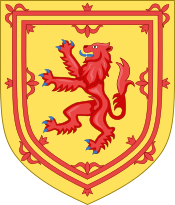
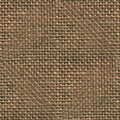
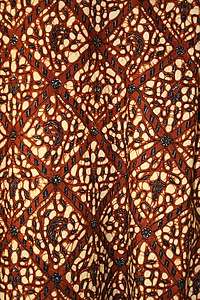
.svg.png)